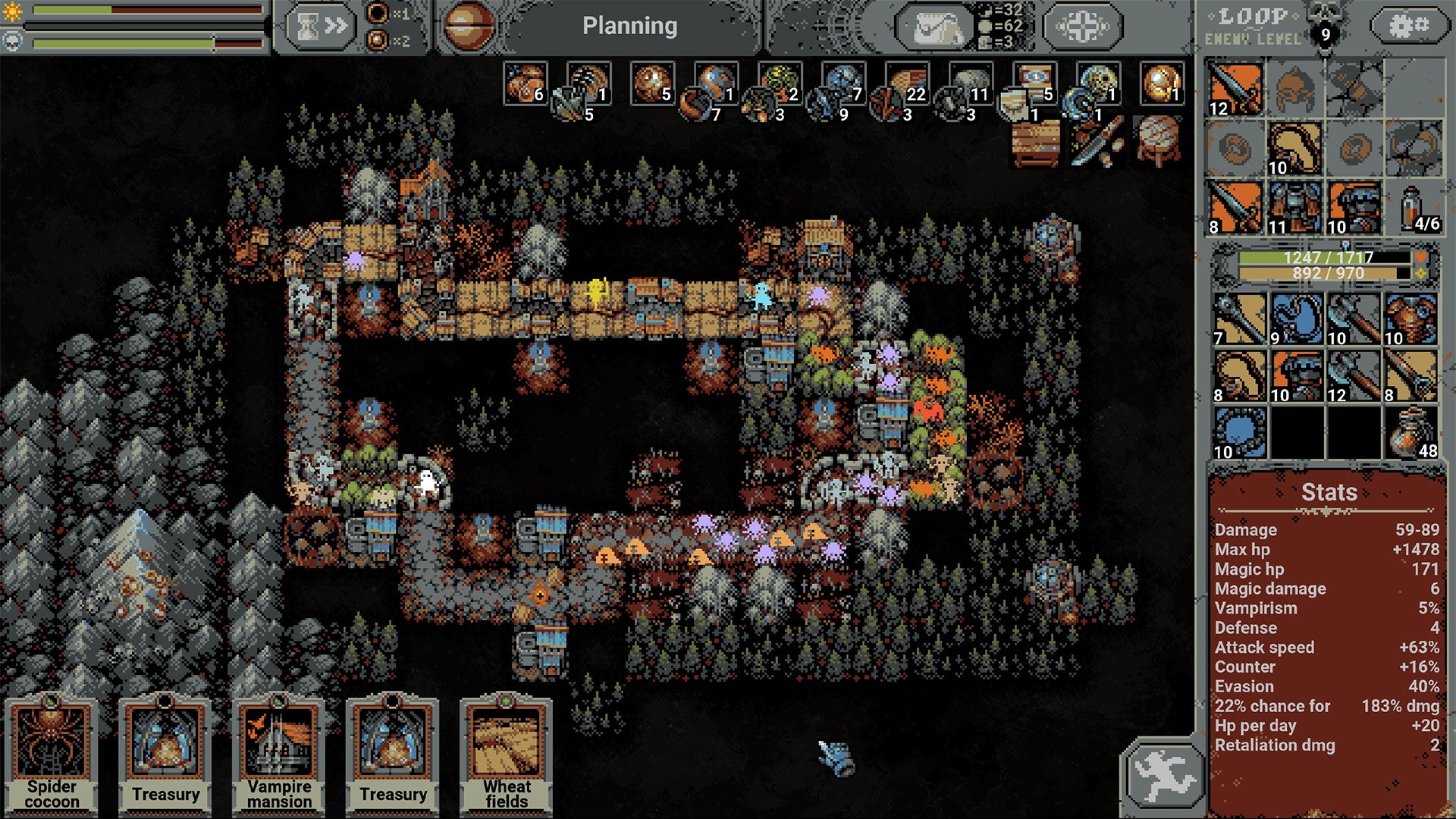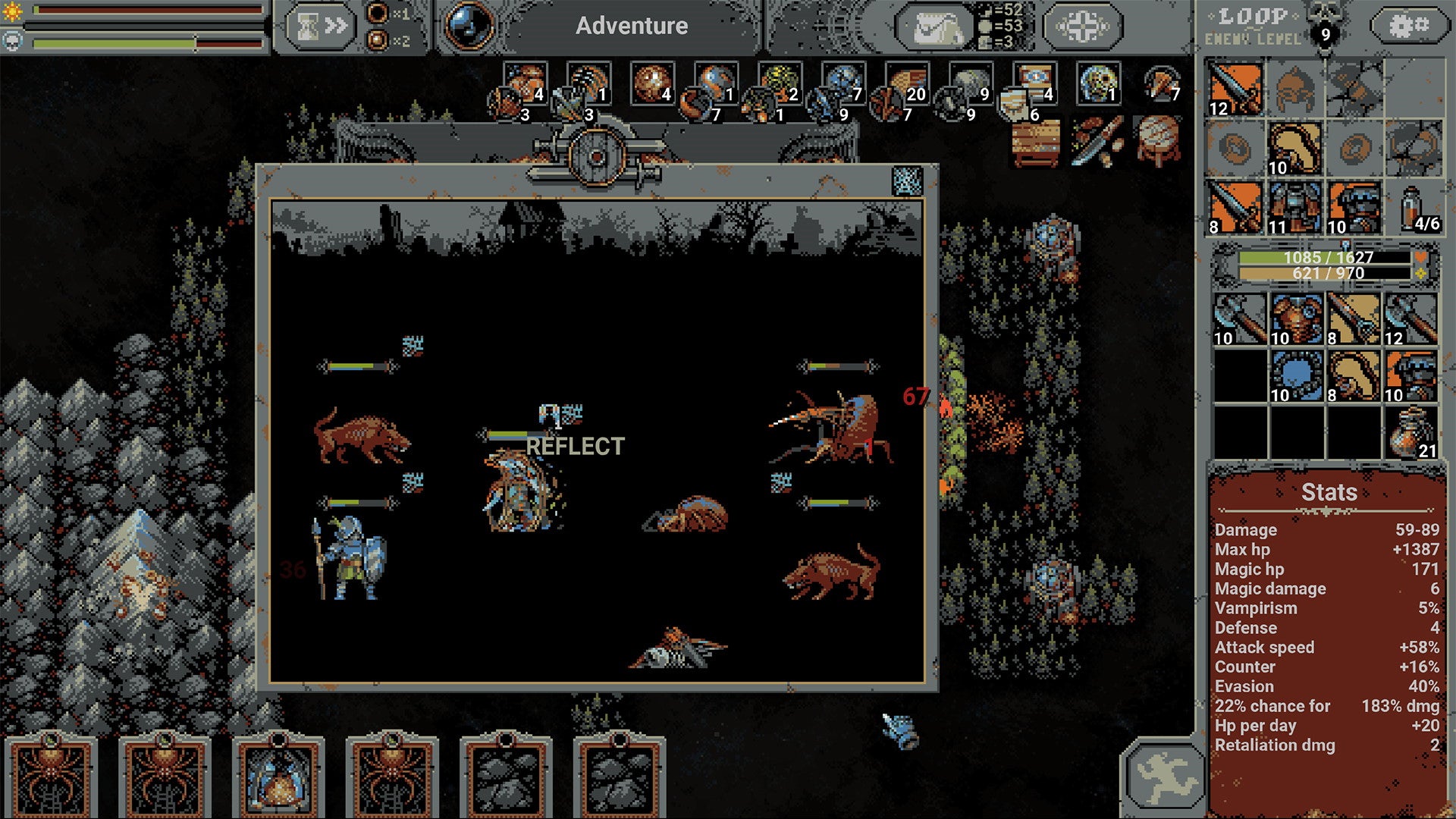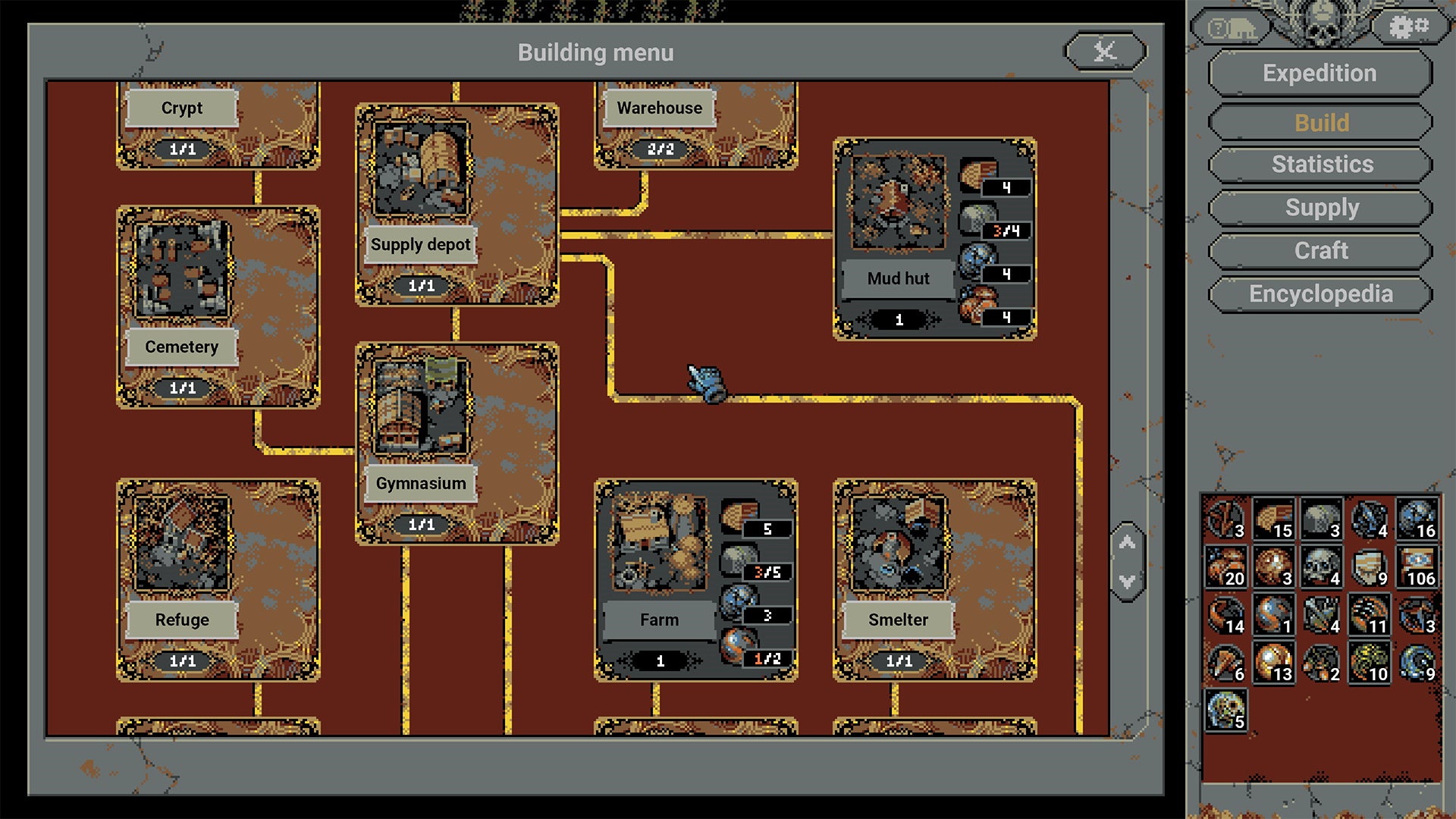Round and round they go, trapped but resolute, like a greyhound on a malfunctioning racetrack, where someone forgot to turn off the hare and the crowds have long since gone home. Your hero will do this for as long as you let them, or until they die, because with each completed loop the monsters become incrementally tougher. To counter this, you can continually dress your hero up in the weapons and armour that monsters drop to improve their abilities. The quality of the loot you collect depends on the type and quantity of the monsters in your path, so it’s in your interest as the world’s overlord to populate your hero’s loop with things to swing a sword at. Defeated enemies also drop cards representing different buildings, places or magic effects. These can be held, or placed on the loop to present your hero with a new obstacle to overcome, and so a reward to reap. Drop a cemetary on the loop and your hero can battle a skeleton each time they pass through. Stick a lantern on a corner and its light will reduce the number of nearby monsters, making one small section of the loop that bit more hospitable. Environmental tiles such as forests, deserts and mountains can be placed everywhere outside the loop, partly as decoration, partly to grant teeny stat buffs that accumulate over time as you fill in the empty landscape, like if Bob Ross were a dungeon master. How each building affects the ones around it is a matter for experimentation. Place a village on the path and it will heal your hero each time they visit, as well as giving them a quest to kill a specific monster somewhere else on the loop for bonus experience points. Stick a vampire mansion next to the village and the village becomes damned, no longer giving any health benefits but instead populated by tough ghoul enemies. After three loops of this, the damned village evolves into a kind of super village, hardened by its vampiric overlord and now able to offer you twice as much health as before. As you play, the empty loop gains character, winding through bucolic strips of villages and wheat fields, to dangerous alleys where you’ve been overzealous with haunted ruins, spider coves and bloody battlefields. Some enemy tiles will spawn automatically as punishment for building too much of a good thing, such as the goblin forts which are conjured into existence for every ten rock cards you put down. You have cards that can remove unwanted tiles, but never enough of them, so you’re rarely in complete control of the shape of the world. A grubby little bandit camp will spring from the earth like a grease stain on your otherwise immaculately planned loop. Here’s where Loop Hero gets less coherent. The game encourages you to create enough monsters for your hero to fight against and become stronger, so when these additional monsters show up of their own volition, it can be difficult to understand whether you’re being rewarded or punished. There’s an uneasy dissonance between your goal (help the hero win) and the only real action you can take (create a world that’s actively trying to murder them). That mismatch hangs over everything you do, but once you’ve memorised enough of the card effects and understand how they affect your hero’s chances of survival, you fall into a fun and compelling rhythm of repeatedly bringing the hero to the brink of their abilities before backing off again. Some enemies are weaker and drop much better stuff, and so they’re more valuable to have on your loop in small amounts. The game never quite explains this, so the first few hours are spent thwacking different monster types and paying close attention to how colourful the swords they drop are. It’s an opaque learning curve, one that will have you googling the various cards to see what they do, but Loop Hero gives you ample opportunity to try different approaches and doesn’t punish failure too harshly. Your goal is to have the hero do as many laps of the loop as they can before it grows too challenging, hoovering up resources to bring back to your basecamp for expansion. Upgrading buildings here gives you permanent stat boosts, new character classes and additional cards to take back out on the loop, making it easier to survive longer, collect more resources and ultimately defeat each of the end bosses of each chapter. As someone who, when confronted with a choice between two iron daggers with very similar but not identical stats, would more easily slip into an indecision-induced coma than pick one, the concept of deck building terrifies me. Somebody once told me that there are more ways to arrange a deck of cards than there are grains of sand on every beach on Earth, plus any extra beaches that might be in space. If you shuffle a deck of cards, it is a statistical near-certainty that nobody in the history of humanity, not even that guy at the casino whose job it is to shuffle cards all day, has held that particular arrangement of cards in their hand before. If you ever want to do something that is, according to science, basically impossible, just shuffle a standard deck of playing cards. The expanse of strategic freedom offered by true deck building games is paralysing. Thankfully, Loop Hero isn’t. This is a very pleasant kind of gentle deck building, with friendly bumpers preventing you from putting too many or too few of the wrong things in your deck. Your deck isn’t tested by an opponent’s set of opposing cards; instead, the composition of your deck forms the paintbox with which you colour in the world. And really, there are only a handful of cards to ever swap in or out. The deck building part of Loop Hero is about making slight adjustments to a basic set of cards, adding in building types you enjoy and the associated combo cards to suit your next expedition. Anyway, I’ve somehow made it this far into my review without making it abundantly clear that I am hooked on Loop Hero. It is barely interactive, but never becomes an idle game and refuses to let you look away for too long. On later loops, once every inch of the map is covered in spiders and valkyries and blood, the loot falls thick and fast. But your inventory is only so large. Any old items get pushed off the bottom of the screen, so you have to be there, fingers poised, ready to alt-tab back into the game to catch a level 28 cudgel with a +32% attack speed before it evaporates. At the end of each loop you arrive, inevitably, because of how loops work, back at the camp. It’s here that you have the option to cash out your winnings or jump back into the fray for another go around. To stick with the teamaker or gamble for the speedboat. To face the elaborate obstacle course you set for yourself, only this time the ratwolves will have sharper teeth, the skeleton archers keener eyes. A game about walking in circles, Loop Hero has every right to feel futile, but the opposite is true. There’s something profoundly rewarding about repeatedly finding yourself back where you started, having gone absolutely nowhere and done nothing, but having a slightly better pair of boots than when you set out. Loop Hero is a peculiar blend of hands-off roleplaying and light card-based strategy. It is a cosy, compulsive thing.



